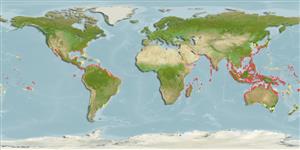Common names from other countries
Classification / Names / Names
Namen | Synonyme | Catalog of Fishes (gen., sp.) | ITIS | CoL | WoRMS
Environment: milieu / climate zone / depth range / distribution range
Ökologie
. Tropical
Atlantic Ocean: in the Caribbean (in Lesser Antilles). Indian Ocean: from Djibouti to South Africa, including Reunion, east to India and south to Western Australia, including Andaman and Nicobar Islands. Pacific Ocean: from China to the South China Sea south to Queensland Australia, including Lord Howe Island and Fiji, east to the Hawaiian Islands.
Length at first maturity / Size / Gewicht / Alter
Maturity: Lm ? range ? - ? cm
Thalli consist of many terete branches, tapering to acute tips, densely covered with 1 to 8 mm long spinose determinate branchlets arranged in whorls, forming distinct nodes and internodes at the distal portions of the branches. Cross-section of a branch reveals a dense core of thick-walled and very small rhizoidal cells. Thalli up to 30 cm in height (Ref. 80758). The fusion of branches upon coming in contact with each other and their ability to form secondary holdfasts at tips of branches results in the formation of thick and strongly attached clumps or carpet-like beds (Ref. 80758).
Used for human consumption in stews, eaten fresh, or blanched in boiling water, or made into Eucheuma candy, or as garnishing; principal source of phycocolloid carrageenan (iota); controls heavy metal pollution (Pb, Cd); used as manure in industrial products and processes; used in animal feeds (Ref. 80758).
Guiry, M.D. and G.M. Guiry. 2009. (Ref. 80701)
IUCN Rote Liste Status (Ref. 130435: Version 2024-1)
CITES Status (Ref. 108899)
Not Evaluated
Not Evaluated
Bedrohung für Menschen
Nutzung durch Menschen
Fischereien: kommerziell
FAO - Aquakultur: production; | FishSource |
Tools
Mehr Information
NamenSynonymeRäuberFortpflanzungGeschlechtsreifeAblaichenFecundityEierEientwicklung
Alter/GrößeWachstumLänge-GewichtLänge-LängeMorphologieLarvenDichte
Internet Quellen
Estimates based on models
Preferred temperature
(Ref.
115969): 24.7 - 29.3, mean 28.2 (based on 3630 cells).
